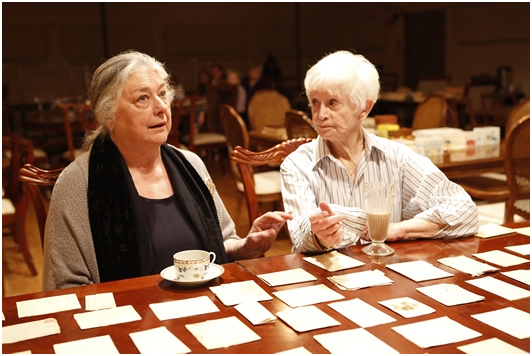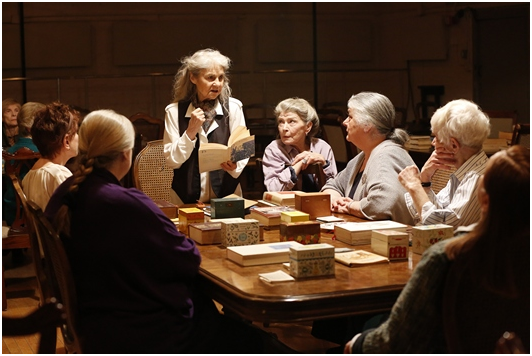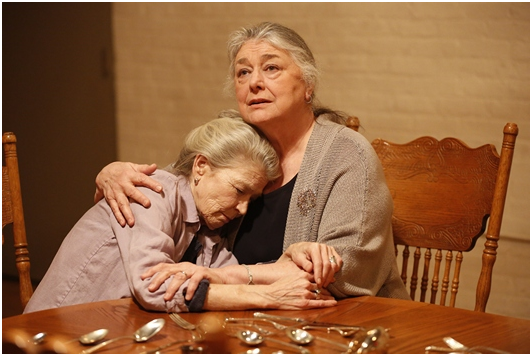I Remember Mama
Either the viewer becomes used to the conceit of the actresses playing characters not their own ages or there are more scenes with mature adults, but the strangeness of the casting fades away and the scenes between Mama and famous author Florence Dana Moorhead and the scenes at Uncle Chris' bedside between his sisters and his woman are extremely moving.

Barbara Andres as Mama and Barbara Barrie
as Katrin in a scene from Transport Group Theatre
Company’s revival of I Remember Mama
(Photo credit: Carol Rosegg)
Transport Group Theatre Company has become famous for their environmental stagings of new and classic American plays and musicals: The Boys in the Band in a loft apartment, Lysistrata Jones in a basketball court, Hello Again in a cabaret setting, etc. Now it the midst of its “20th Century Project,” a ten-year cycle of ten productions, each focusing on a different decade of the 20th century, Transport Group has chosen John Van Druten’s beloved I Remember Mama, the successful Broadway adaptation of Mama’s Bank Account by Kathryn Forbes which ran from 1944 – 1946 and played a total of 713 performances. Set in San Francisco during the years 1910-1912, I Remember Mama represents the second decade of the 20th century and the second offering in the project. Not seen in a major New York revival, the play has been turned into a Hollywood movie, a television series and Richard Rodgers’ last Broadway musical.
I Remember Mama tells the story of the extended Norwegian Hanson family of San Francisco: Mama, Papa, oldest daughter Katrin who wants to be a writer, only son Nels who wants to go to high school (created by Marlon Brando in his Broadway debut), and younger daughters Christine and Dagmar (who only has eyes for her cat Elizabeth). Also there are Mama’s three sisters, domineering and judgmental Jenny, complaining Sigrid, and timid unmarried Trina. And ruling the family through fear is unmarried Uncle Chris (who shocks his sisters by living with a woman not his wife), whose whereabouts nobody knows and who makes periodic visits to bring boxes of oranges and to see how his sisters are doing. Mama has a boarder, the English Mr. Hyde, a theatrical type, who gives dramatic readings of British and American classics to the family in the evenings from a treasure trove of his collection.
With sensitivity and compassion, the play covers two years in the lives of the Hansons leading up to Katrin’s graduation from high school and her getting her first story accepted for publication. In the course of that time, Dagmar needs an operation, Aunt Trinia desires to marry Mr. Thorkelson from the funeral parlor but wants Uncle Chris’ blessing, Katrin desperately wants a pink celluloid dresser set in the drugstore window for her graduation present, and Uncle Chris becomes very ill. Each week there is a mutual sigh of relief, when Papa’s check is allotted for expenses and the Hanson family does not have to make use of “Mama’s bank account” at a downtown bank, but only the “little bank” kept at home in a small box. Each act begins with the older Katrin (played by the same actress as the teenager) reading from her writings which opens that part of the play. All of the problems are usually solved by Mama who holds the whole clan together both with her advice and her spirit.

Lynn Cohen as Mr. Hyde reading to the family,
Phyllis Somerville, Barbara Andres and cast
in a scene from I Remember Mama
(Photo credit: Carol Rosegg)
Director Jack Cummings III has not only chosen a new environment for this realistic play, he has also chosen to perform it with ten veteran actresses (who would be classified as senior citizens) playing all 23 parts, including teenage girls and boys, and all the male characters. When the audience enters the Gym at Judson the entire space has been turned into the playing area with seats in two rows around all four walls. Ten dining room sets with displays on each occupy the space, the size of a basketball court. Organized around one theme per table, these include glassware, tea cups and saucers, typewriters, books, linen napkins, letters, postcards, silverware, etc., all representing the 1910 era: a veritable museum of the period. Although the audience is not invited to view the exhibits, many do on their way to their seats. When the play begins, nine of the actress, all dressed in pants, file in and take a seat, each at her own table, leaving the center one empty. As Barbara Barrie as Katrin begins reading her journal to the other, Mama played by Barbara Andres appears, goes to the middle table set with various items, and the play begins in earnest. It is as though Katrin’s memories have conjured her up.
Except for Barrie’s Katrin and Andes’ Mama, all of the other actresses play between two and three parts each. Both Lynn Cohen and Heather MacRae play only male roles: the diminutive Cohen plays the English boarder Mr. Hyde and brooding Norwegian Uncle Chris, while the tall MacRae plays both son Nels and suitor Mr. Thorkelson. Not only does it take the whole first act to get adjusted to seeing these ladies of a certain age playing teenagers as well as male roles in which they would normal not be cast, but the first act plays like a rehearsal of a staged reading, with the cast using different tables to represent the different locales, the Hanson home, the hospital, Aunt Jenny’s kitchen, the street, etc. With many of the scenes played in the limited space between the tables, the staging by necessity is such that at times the actresses block each other from viewers at one angle or another. Also the acoustics at the Gym at Judson are such that when the performers have either their backs to one side of the venue or are at the opposite side from the viewer, it is difficult to hear the dialogue.
And then something extraordinary happens in the second half. Either the viewer becomes used to the conceit of the actresses playing characters not their own ages or there are more scenes with mature adults, but the strangeness of the casting fades away and the scenes between Mama and famous author Florence Dana Moorhead and the scenes at Uncle Chris’ bedside between his sisters and his woman are extremely moving. Then the play begins to work in this unique environmental staging and is ultimately quite satisfying.
or
Phyllis Somerville and Barbara Andres
in a scene from I Remember Mama
(Photo credit: Carol Rosegg)
Why did Cummings choose to use this gimmick or device for a play not seen on our stages since 1946? As a play for voices like a live radio drama? Was it that the need for 23 performers was economically daunting? Did the play’s sentiment seem anathema to the current generation? Was it thought that the events of the play were too banal or mundane? Did he want the combined experiences of these veterans for a story that is set 100 years ago? Does he see this as a memory play of deeply felt experience? Or was it that this story of a family of mainly strong women and few men ought to be played this way? There is no director’s note in the program, so that one guess is as good as another. In any case, it is certain to gain attention and provoke controversy.
The cast is generally memorable except where it is difficult to imagine a veteran actress in such a role. As Mama, Andres (the original Broadway production of On Golden Pond) with a credible Norwegian accent is an indomitable presence, warm and comforting, able to find a solution to all problems. Barrie (the original production of Sondheim’s Company) as Katrin has all the vulnerability of a young girl going through darkest adolescence, though it is a bit hard to visualize her initially as age 13 with her white pixie haircut. Rita Gardner (the original casts of The Fantasticks and The Wedding Singer) is lovely as the timid Trina who eventually finds her own strength. As the other aunts, Alice Cannon (the original Broadway productions of Company and James Joyce’s The Dead) and Susan Lehman (the original productions of I Can Get It for You Wholesale and The Prisoner of Second Avenue) make them decidedly different: Cannon’s Aunt Jenny is all bossy pronouncements while Lehman’s Sigrid is always whining about how she is treated by the other members of her family.
As the other Hanson children, Louise Sorel (the original West End and Broadway productions of Rattigan’s Man and Boy and Vivian Alamain on Days of Our Lives from 1992-2012) is all jealous girlishness, while Phyllis Somerville (the original production of Over Here! as well as her recurring role as Marlene on The Big C opposite Laura Linney) as the youngest child Dagmar is convincing in her insistent enthusiasms. MacRae (the original casts of the Broadway musicals Falsettos and A Catered Affair) is a bit bland as both Nels and Mr. Thorkelson, arguably the least well written roles in the play. Sorel is even better as the snobbish celebrity author Florence Dana Moorhouse who melts when Mama plays up to her gastronomic interests. Dale Soules (the Broadway musicals The Magic Show and Hands on a Hardbody) brings quiet dignity to Papa, a wounded dignity to Dr. Johnson, and a boyish joy to Cousin Arne. The most difficult one to evaluate is Cohen (Louis Malle’s Vanya on 42nd Street and her role of Magda in Sex and the City I and II) as both Mr. Hyde and Uncle Chris. While she gives excellent nuanced performances as the cultured Mr. Hyde and the intimidating Uncle Chris with fine accents, it is difficult to picture her in these roles.
The production design by the team of Dane Laffrey (scenery), Kathryn Rohe (costumes), R. Lee Kennedy (lighting) and Alicia Bullen (props) is always in evidence and takes a bit of getting used to. Jack Cummings III’s production of John Van Druten’s I Remember Mama with ten of America’s most accomplished veteran stage actresses forces the viewer to see the play in a new way which is probably what theater art is all about. This unusual production makes an interesting contrast to Van Druten’s London Wall, now having its American premiere at the Mint Theater in a totally conventional and realistic staging which is also set to run through April 20.
I Remember Mama (through April 20, 2014)
Transport Group Theatre Company
The Gym at Judson, 243 Thompson at Washington Square South, in Manhattan
For tickets, call 866-811-4111 or visit http://www.transportgroup.org
Running time: two hours and 30 minutes with one intermission






Leave a comment